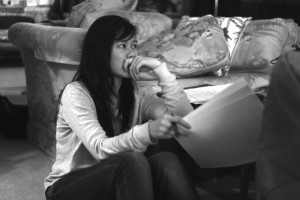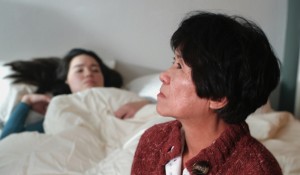She’s an emerging artist. She’s an independent filmmaker, who has a new film in production called “Adrift in Sunset.” SIDEWALKS’ own Lisa Drittenbas introduces us to Narissa Lee.

Independent filmmaker Narissa Lee lives in San Francisco and earned a degree in Film and Digital Media from UC Santa Cruz. Her 2011 short film, “The Bus Pass,” received the Audience Award for Best Lesbian Short at Hamburg International Lesbian & Gay Film Festival.
Her new film, “Adrift in Sunset,” is a 25-minute short that delivers an emotional punch. It’s about a daughter caring for her mother with Alzheimer’s who decides to take her mom along on a date with a new romantic interest. I sat down with Narissa at a café in the Richmond District for a Q & A about her film, her goals and her inspirations.
Lisa: What inspired you to get in to filmmaking?
Narissa: It was by accident. My other major was Community Studies, then I took an Asian Cinema class at UC Santa Cruz and found out I liked it. There’s that quote from Bjork, “There are certain emotions in your body that not even your best friend can sympathize with, but you will find the right film or the right book, and it will understand you.”And I watched these films by Asian filmmakers and they spoke to me. I thought, “Wow, these films really get me.” I never saw films that moved me so much. And the interesting thing was that these were not Asian American films – they were Southeast Asian, Indian, Chinese, Japanese. They just got some of the familial relationships and the social aspects, and even the technical aspects were different from American movies. Like Stanley Kwan’s “Center Stage,” a biopic in which he included documentary elements, like real footage that blends into the layers of the story. I found that intriguing. I dropped the Community Studies and studied Film & Digital Media.
Lisa: Several of your films explore LGBT relationships. Do you prefer to be known as an LGBT filmmaker, or how do you perceive such labels?
Narissa: I think we all inhabit a socio-political space, and I’d rather admit it than deny it. It doesn’t make me any less of a filmmaker to be called an Asian Filmmaker, or an LGBT Filmmaker; I’m ok with those labels. There’s a part of embracing that. You can also be an LGBT filmmaker and not make LGBT films.
Because of my name, most people don’t know I’m Asian. I went to a Pasadena internship and half the people thought I was going to be black! The others thought I was going to be Asian or white, and they had a betting pool! I think as a filmmaker the lens that I see the world through is something I’ve chosen to confront in my pieces. “Adrift in Sunset” is confrontational, in that the characters confront their problems, as opposed to running away from them.
Lisa: I saw “Adrift in Sunset” and it made me cry. Twice. How do you pack so much emotion into a 25-minute film?
Narissa: I thought of it like a “capsule of life,” a depiction of the range of emotions we go through on a daily basis. I intended the main character, Dao, to be understated, not really showing the impact of things on her emotionally, because that’s how she’s really able to get through the day. This film is unpacking or getting through the layers without the character really realizing it.
When I started writing this piece I had to approach it in a very human way; I was each character when I was writing it, and it was really, really hard to put on each persona and have to create layers through which they live life. But you have to also peel them away and get to the heart of what moves them. And that was really intense. Part of it was because I’ve lived those roles myself.
My mom had Alzheimer’s’ for 20 years. At the end of 2013, I went to a friend’s mother’s eulogy, which was beautiful. I came back to the idea of sharing an emotional experience and to re-gift that, in terms of the emotional experiences I’ve had with my mom, and started to write the script.
Lisa: What are your plans for “Adrift in Sunset?” Will it be shown at film festivals, or locally?
Narissa: The plan is to finish it. Color grade, score, sound mix, finish the editing. And to submit it to as many festivals as we can afford to. For film festivals you pay an entry fee and you don’t know if you’re going to get in. Entering 10 festivals is close to $600-$1000 right there.
I have high hopes – I hope it makes it to Sundance, to Berlin, Cannes, Pusan, and other international film festivals. And I hope it premieres in San Francisco. In order to complete it, we have to have a successful indiegogo campaign. We’ve raised about $2700, and the goal is $6000. If we don’t make the goal, we don’t get to keep any of the money. So we hope we make the goal!
Lisa: What are some of your other goals as an artist and filmmaker?

Narissa: I think film is a great place to confront people we don’t normally come across everyday. I’m not interested in tolerance. I’m interested in using film as a way to encourage people to engage in honest conversation with other people. Including people they don’t normally come across or deal with every day. It involves working thought our differences, not pretending we don’t have any. Provoking deep conversation. People are not all the same, but we can definitely have empathy and respect for one another.
My goal is to continue to make work that is thought provoking, compelling, or at least fun. There is some really good, compelling TV, but I think there could be more of that, like great literature that critiques where we are and how we think about moving forward.
Lisa: Any advice for people who are interested in getting in to filmmaking?
Narissa: You should just do it. It’s fun! I have a full time job and I am also doing this.
Doing “Adrift in Sunset” confirmed that I love doing this. Being in the edit room and trying to craft this multi-sensory experience for people – that is so interesting, so enjoyable for me. You’re like a DJ – you want people to have a good time. You’re blending things and taking various elements that people may not think go together, posing questions for people to think about and relate to their own lives, and make it their own. I want people to be able to latch on to things and feel free to have their own interpretation of what they’re watching. I find that compelling. I find that part of it to be powerful.
Also, in order to be creative I’ve learned that I have to stop judging. Stop judging myself and others, just be a more open person, open to feedback. Keep in mind that not everything you do is going to be great; I like to have permission to make things that are stupid. So just get your feet wet and give it a try.
Narissa Lee’s indiegogo campaign is going on until March 18th 2015.
